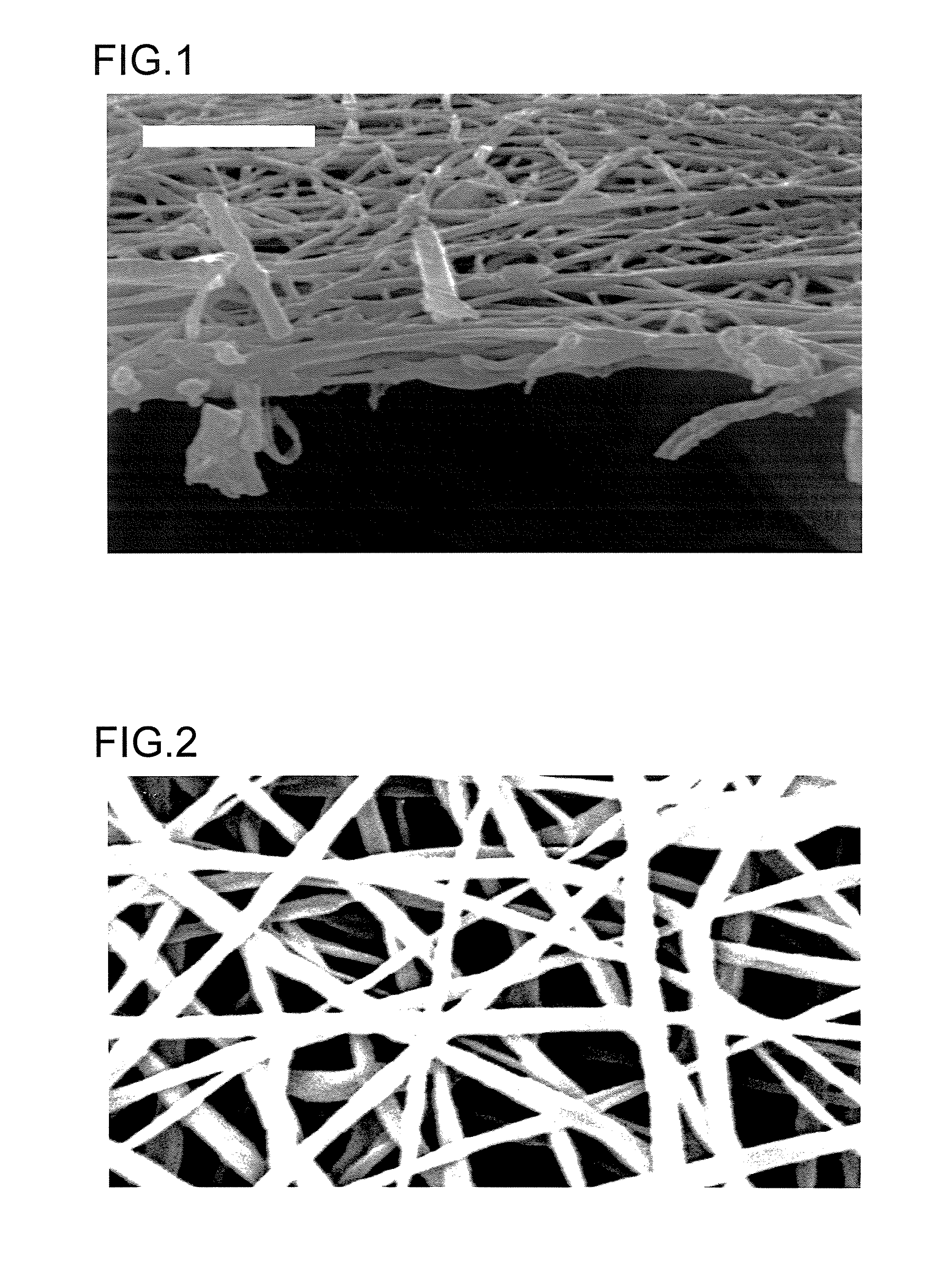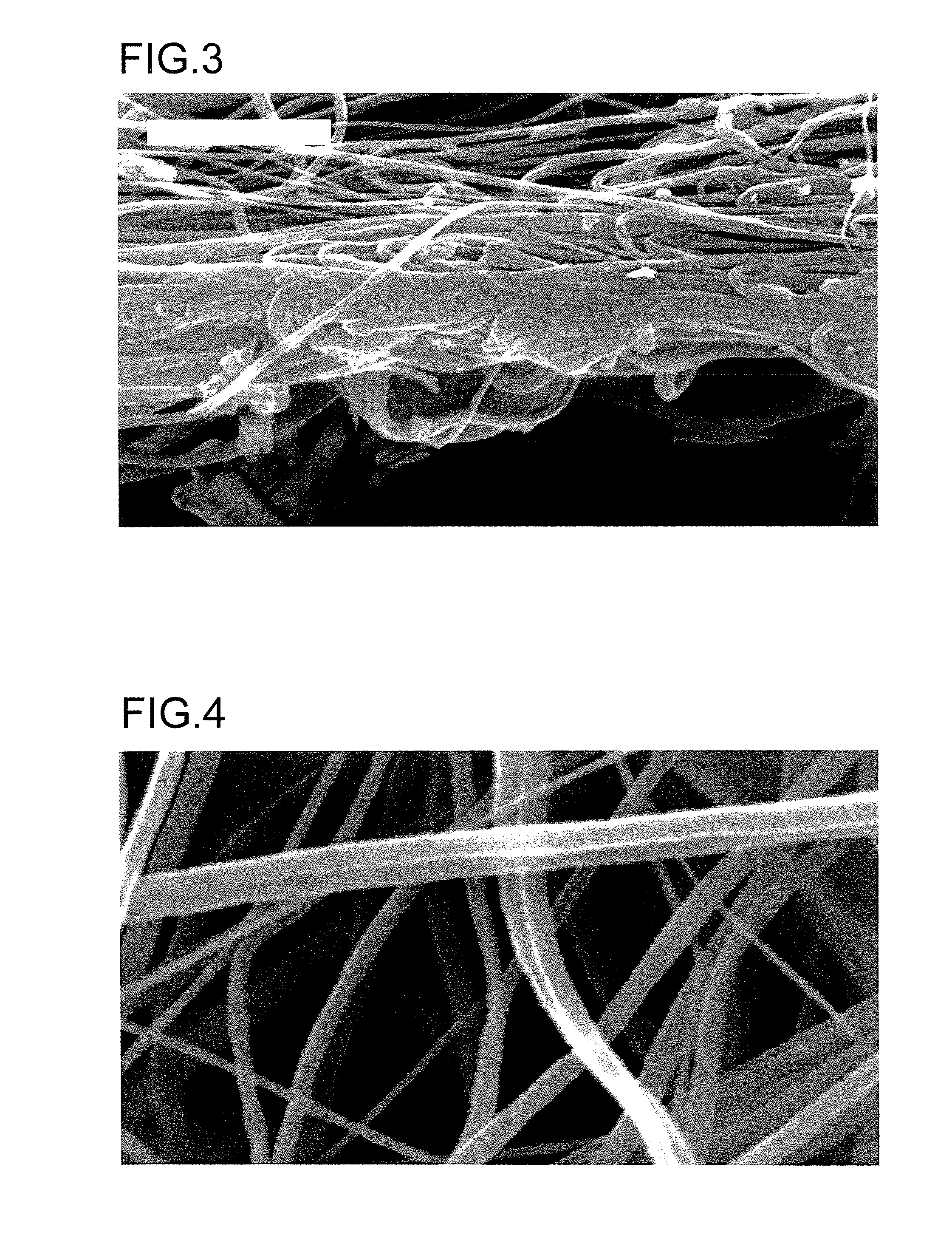Fluoropolymer fine fiber
a technology of fluoropolymer and fine fiber, which is applied in the field of fine fiber nonwoven layers of fluoropolymer, can solve the problems of shifting the melting point and changing the solubility properties of materials, and achieves the effect of high stability to heat and pressur
- Summary
- Abstract
- Description
- Claims
- Application Information
AI Technical Summary
Benefits of technology
Problems solved by technology
Method used
Image
Examples
example 1
[0101]A polymer solution was obtained by combining polymer and solvent in a 500 ml glass kettle with a 3-neck lid, to which mechanical stirring, a temperature probe, and a condenser were attached. The vessel was placed in a heating mantle and the temperature controlled at 45° C. under constant agitation until a uniform solution was obtained. The solution was cooled to room temperature before electrospinning.
[0102]The solution composition was 9 wt % Dyneon™ THV 220A (from Dyneon LLC of Oakdale, Minn.), in acetone. After the solution had reached room temperature, sodium iodide was added to a final concentration of 0.05% of the solids, with continuous agitation until the salt had completely dissolved.
[0103]The solution was electrospun onto a silicone impregnated cellulose substrate (available as FF6168 from Hollingworth & Vose Company of East Walpole, Mass.) via a syringe, whereby flow was controlled through a syringe pump at 0.05 ml / min. The distance between the emitter (needle) and t...
example 2
[0105]A polymer solution was prepared as in Example 1 by combining polymer and solvent in a container with constant agitation until a uniform solution was obtained.
[0106]Solution composition was 9 wt % solids total, wherein the solids were about 50 / 50 Solef® 26106 / Solef 25108® (from Solvay S. A. of Brussels, Belgium), in acetone. After the solution had reached room temperature, sodium iodide was added to a final concentration of 0.05% of the solids, with continuous agitation until the salt had completely dissolved.
[0107]The solution was electrospun onto a silicone impregnated cellulose substrate (available as FF6168 from Hollingworth & Vose Company of East Walpole, Mass.) via a syringe, whereby flow was controlled through a syringe pump at 0.05 ml / min. The distance between the emitter and the substrate was fixed at 4 inches. The applied voltage was 25 Kvolts. The thickness of the resulting fine fiber mat was 3 μm, with an average fiber diameter of 0.3 μm.
[0108]FIGS. 3 and 4 show pho...
example 3
[0109]A polymer solution was obtained using the technique employed in Example 1 by combining polymer and solvent in a container with constant agitation until a uniform solution was obtained. The materials used, solution composition, and electrospinning conditions were identical to those of Example 2.
[0110]Longer fiber deposition time at the same rate as used in Example 2 resulted in a fine fiber mat with 30 μm thickness, with an average fiber diameter of 0.3 μm. FIGS. 5 and 6 show photo micrographs of the fibers produced under these conditions. FIG. 5 shows a 1000× cross section SEM micrograph of the fine fiber mat produced in Example 3. FIG. 6 shows a 10,000× magnification SEM micrograph of fine fibers produced as in Example 3. The discrete fine fiber structure of the invention is visible in these micrographs.
PUM
| Property | Measurement | Unit |
|---|---|---|
| thickness | aaaaa | aaaaa |
| diameter | aaaaa | aaaaa |
| diameter | aaaaa | aaaaa |
Abstract
Description
Claims
Application Information
 Login to View More
Login to View More - R&D
- Intellectual Property
- Life Sciences
- Materials
- Tech Scout
- Unparalleled Data Quality
- Higher Quality Content
- 60% Fewer Hallucinations
Browse by: Latest US Patents, China's latest patents, Technical Efficacy Thesaurus, Application Domain, Technology Topic, Popular Technical Reports.
© 2025 PatSnap. All rights reserved.Legal|Privacy policy|Modern Slavery Act Transparency Statement|Sitemap|About US| Contact US: help@patsnap.com



